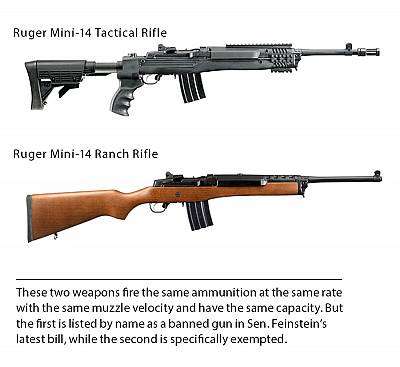Neither 'Capacity' Nor 'Power' Distinguishes 'Assault Weapons' From Other Firearms
The New York Times continues to push the myth that there is something uniquely deadly about the guns Dianne Feinstein wants to ban.

In an editorial published the day after the shooting that killed 11 people at a Pittsburgh synagogue on Saturday, The New York Times erroneously claimed that so-called assault weapons like the Colt AR-15 rifle used in that attack are distinguished by their "high capacity." In a news story posted yesterday, Times reporter Richard A. Oppel Jr. suggests that AR-15-style rifles are especially "powerful," which also is not true.
Unlike, say, Barack Obama or Hillary Clinton, Oppel acknowledges that an AR-15, like any other semi-automatic, "fires one bullet at a time." Still, he says, "it is a powerful weapon: light, easy to hold and to fire, with limited recoil, its bullets shooting out of the muzzle more than twice as fast as most handgun rounds." The only part of that description that is related to "power" is the part about muzzle velocity, and here Oppel pulls the time-honored trick of comparing the rifles Dianne Feinstein hates with handguns instead of other rifles. Bullets fired from rifles generally move faster than bullets fired from pistols, mainly because a longer barrel gives them more room to accelerate. But that tells us nothing about the difference between the rifles Feinstein wants to ban—which are distinguished by features such as folding stocks, pistol grips, and barrel shrouds—and the ones she is willing to leave on the market.
If the comparison is limited to long guns, the .223-caliber round typically fired by AR-15-style rifles does have a relatively high muzzle velocity. But other cartridges, fired by guns that are not considered "assault weapons," equal or surpass it. Furthermore, muzzle velocity is not the only factor in a bullet's lethality; size also matters, and so-called assault weapons fire smaller rounds than many hunting rifles.
Oppel adds that "the standard AR-15 magazine holds 30 bullets and can be swapped out quickly, allowing a shooter to fire more than a hundred rounds in minutes." The ability to accept "high-capacity" magazines does not distinguish "assault weapons" from other guns, and Oppel's point about how quickly magazines can be switched undermines the argument that a 10-round limit would make mass shootings less deadly. In any case, any semi-automatic gun can fire "more than a hundred rounds in minutes," which would require, at most, pulling the trigger about once per second.
The Times has been helping to perpetuate the myth that there is something uniquely deadly about "assault weapons" for decades. But it also has intermittently published articles pointing out that the distinctions drawn by politicians like Feinstein make little sense, or at least acknowledging that perspective. Critical readers, even if they had no other source of information about "assault weapons," should be able to figure out that there is something fishy about the case for banning these guns. It's too bad there are not more of those on the paper's editorial board or reporting staff.


Show Comments (297)